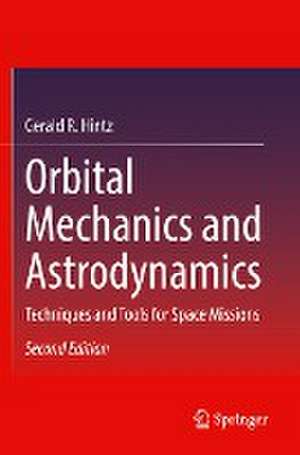Orbital Mechanics and Astrodynamics: Techniques and Tools for Space Missions
Autor Gerald R. Hintzen Limba Engleză Paperback – 12 ian 2024
Orbital Mechanics and Astrodynamics: Techniques and Tools for Space Missions is ideal for studentsin astronautical or aerospace engineering and related fields, as well as engineers and researchers in space industrial and governmental research and development facilities, as well as researchers in astronautics.
| Toate formatele și edițiile | Preț | Express |
|---|---|---|
| Paperback (2) | 458.51 lei 38-45 zile | |
| Springer International Publishing – 14 oct 2016 | 458.51 lei 38-45 zile | |
| Springer International Publishing – 12 ian 2024 | 476.23 lei 38-45 zile | |
| Hardback (1) | 608.55 lei 38-45 zile | |
| Springer International Publishing – 12 ian 2023 | 608.55 lei 38-45 zile |
Preț: 476.23 lei
Preț vechi: 587.94 lei
-19% Nou
Puncte Express: 714
Preț estimativ în valută:
91.13€ • 97.45$ • 75.98£
91.13€ • 97.45$ • 75.98£
Carte tipărită la comandă
Livrare economică 14-21 aprilie
Preluare comenzi: 021 569.72.76
Specificații
ISBN-13: 9783030965754
ISBN-10: 3030965759
Pagini: 448
Ilustrații: XXV, 448 p. 226 illus., 16 illus. in color.
Dimensiuni: 155 x 235 mm
Greutate: 0.85 kg
Ediția:2nd ed. 2022
Editura: Springer International Publishing
Colecția Springer
Locul publicării:Cham, Switzerland
ISBN-10: 3030965759
Pagini: 448
Ilustrații: XXV, 448 p. 226 illus., 16 illus. in color.
Dimensiuni: 155 x 235 mm
Greutate: 0.85 kg
Ediția:2nd ed. 2022
Editura: Springer International Publishing
Colecția Springer
Locul publicării:Cham, Switzerland
Cuprins
1. Fundamentals of Astrodynamics.- 2. Keplerian Motion.- 3. Orbital Maneuvers.- 4. Techniques of Astrodynamics.- 5. Non-Keplerian Motion.- 6. Spacecraft Rendezvous.- 7. Navigation and Mission Design Techniques and Tools.- 8. Changing from Mission Design to Flight Operations.- 9. Further Study.
Notă biografică
Dr. Gerald Hintz is an Adjunct Professor in the Department of Astronautical Engineering at the University of Southern California. He was a technical manager and senior engineer at NASA’s Jet Propulsion Laboratory for 37 years before his retirement. He worked on the development and flight operations of space missions, including Viking I and II (two orbiters and two landers to Mars), Mariner 9 (orbiter to Mars), Seasat (an Earth orbiter), Voyager II (for the Neptune encounter), Pioneer Venus (orbiter to Venus), Galileo (probe and orbiter to Jupiter), Ulysses (solar polar mission), Cassini-Huygens (orbiter to Saturn and lander to Titan), and Aquarius (a future Earth orbiter). As a technical manager, he provided multi-mission navigation support via the Deep Space Network, developed a computer-based training and reference tool for the Orbit Determination Program, and provided a successful orbital design for an Earth-orbital mission.
Textul de pe ultima copertă
Now in an updated second edition, this classroom-tested textbook covers fundamental and advanced topics in orbital mechanics and astrodynamics designed to introduce readers to the basic dynamics of space flight. It explains concepts and engineering tools a student or practicing engineer can apply to mission design and navigation of space missions. The text also provides excellent insight into astronautical techniques and tools by highlighting basic, analytic, and computer-based methods for designing interplanetary and orbital trajectories. The second edition includes new material on the observational basics of orbit determination, information about precision calculations for data used inflight, and improvements in mission design procedures.
Orbital Mechanics and Astrodynamics: Techniques and Tools for Space Missions is ideal for students in astronautical or aerospace engineering and related fields, as well as engineers and researchers in space industrial and governmental research and development facilities, as well as researchers in astronautics.
· Covers fundamental principles to expose students to the basic dynamics of space flight;
· Illustrates all key concepts with examples;
· Includes new homework exercises and numerical answers to selected problems.
Orbital Mechanics and Astrodynamics: Techniques and Tools for Space Missions is ideal for students in astronautical or aerospace engineering and related fields, as well as engineers and researchers in space industrial and governmental research and development facilities, as well as researchers in astronautics.
· Covers fundamental principles to expose students to the basic dynamics of space flight;
· Illustrates all key concepts with examples;
· Includes new homework exercises and numerical answers to selected problems.
Caracteristici
Covers fundamental principles to expose students to the basic dynamics of space flight Illustrates all key concepts with examples Includes new homework exercises and numerical answers to selected problems
